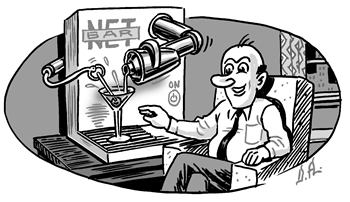Covering CES 2016, the mission was to discover new trends in home automation that will comprise the fabric of tomorrow’s connected world. What makes these new devices unique? How will they improve our lives? What’s being done better than before? We came across a few products that embody the broader industry challenges and opportunities surrounding embedded connectivity - enhanced utility, a cleaner environment, and a need to continue refining product implementation.
 Let’s start with a cocktail. You may be wondering how connectivity found its way into the social fabric of entertaining. Let’s say it’s Saturday night; a message arrives, “you’ve got to try this.” It’s a recipe for a new mixed drink coming from an old friend who lives cross country. Your new connected bar kicks into gear and prepares that drink, shaken or stirred, with the perfect amount of each ingredient. It’s another example of social media and connectivity teaming up to ensure distance doesn’t impair sharing an experience. The challenge this product faces is similar to that of other smart home products: its implementation needs refinement. For it to deliver on its promise you need to have the right ingredients on hand, and your friend also need this nifty new $499 home bar (a rare combination of events).
Let’s start with a cocktail. You may be wondering how connectivity found its way into the social fabric of entertaining. Let’s say it’s Saturday night; a message arrives, “you’ve got to try this.” It’s a recipe for a new mixed drink coming from an old friend who lives cross country. Your new connected bar kicks into gear and prepares that drink, shaken or stirred, with the perfect amount of each ingredient. It’s another example of social media and connectivity teaming up to ensure distance doesn’t impair sharing an experience. The challenge this product faces is similar to that of other smart home products: its implementation needs refinement. For it to deliver on its promise you need to have the right ingredients on hand, and your friend also need this nifty new $499 home bar (a rare combination of events).
Indeed, this is the challenge of the smart appliance sector, long adored as a focal point of CES. Similar to the connected bar, smart appliance awareness remains low at 15 percent of U.S. adults. While implementation has improved, there are still gaps. For example, Samsung just launched a new connected refrigerator with a crisp 21.5-inch touch screen. Each time you close the door, a photo is sent to your smartphone keeping you informed of what you need to pick up at the store. We’ve all been there, at the grocery store not sure if you need milk or ice cream. We’ll, let’s hope you’re not out of ice cream because there is no camera in the freezer. And if that milk if tucked nicely behind the OJ, you will probably return home with another half-gallon as the photo may not capture that hidden carton. Don’t get me wrong, this new fridge offers quite a few useful new features such as cloud-based sticky notes and a built-in speaker. Its screen displays today’s weather while you are cooking breakfast, all packaged with an attractive design. Advancements in the use case are apparent, and refinement will take this concept from the tradeshow floor into the kitchen.
Now that you’ve poured down that cocktail, let’s get into saving the planet. Energy and water conservation, and reduced CO2 emissions, among other environmentally-friendly aspects, are another promise of a connected world. There are numerous examples, including AT&Ts launch of its smart cities initiative in Atlanta, Dallas, and Chicago. The pilot city launch will explore integrating smart lighting, parking, transportation, and infrastructure among other things that promise to improve our lives and environment. In contrast to large-scale efforts such as this, an intriguing new product stands out for its simplicity and environmental impact: a Bluetooth-embedded shower head. No, it doesn’t have a hidden video camera. Its purpose is basic: as you use more water, the color of the shower head changes, prompting you to wrap up and save our planet’s precious natural resources. In drought-prone areas, this sort of product could have a significant impact.
Share a drink with friends from afar, leave virtual notes for family members on the fridge, conserve water, and reduce commute time; the Internet of Things is poised to change our world. As with the technology that came before, it will improve over time, and we’ll quickly forget about the kinks in those trail blazing products.